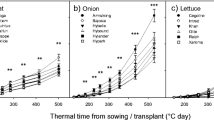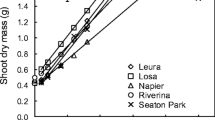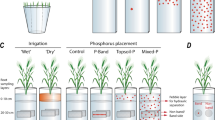Abstract
Modern lettuce cultivars are bred for use under high levels of input of water and nutrients, and therefore less adapted to low-input or organic conditions in which nitrate availability varies over time and within the soil profile. To create robust cultivars it is necessary to assess which traits contribute to optimal resource capture and maximum resource use efficiency. We therefore revisited earlier published results on root growth, resource capture and resource use efficiency of lettuce exposed to localized drought and nitrate shortage in a pot experiment. Root growth in a soil profile with localized resource shortage depended on the resource that was in short supply. We conceptualized a model describing nitrogen uptake and use efficiency. We also investigated the genetic variation among 148 cultivars in resource capture over time and soil depth and in resource use efficiency in four (two locations × two planting dates) field experiments. Cultivars proved to be highly diverse in their ability to capture and use resources. This ability, however, was strongly affected by other sources of variance, stressing the need for an eco-physiological model capable of reducing the residual variance and improving the expression and evaluation of cultivar differences in relation to both resource capture and use efficiency in lettuce. We showed that genetic variation was best expressed under limiting conditions. To improve the conceptualized model further we identified issues requiring further analysis, e.g., the physiological reasons why certain cultivars are capable of quickly responding to changes in the environment to maintain optimal resource capture.



Similar content being viewed by others
References
Barlow PW (2010) Plastic, inquisitive roots and intelligent plants in the light of some new vistas in plant biology. Plant Biosyst 144:396–407
Boriss H, Brunke H (2005) Commodity profile: lettuce. Agricultural Issues Center, Univ of California http://aic.ucdavis.edu/profiles/lettuce-2005.pdf. Accessed 3 Mar 2014
Ceccarelli S, Acevedo E, Grando S (1991) Breeding for yield stability in unpredictable environments: single traits, interactions between traits, and architecture of genotypes. Euphytica 56:169–185
Chapman N, Whalley WR, Lindsey K, Miller AJ (2011) Water supply and not nitrate concentration determines primary root growth in Arabidopsis. Plant Cell Environ 34:1630–1638
Clark MS, Horwarth WR, Shennan C, Scow KM, Lantni WT, Ferris H (1999) Nitrogen, weeds and water as yield-limiting factors in conventional, low-input and organic tomato systems. Agric Ecosys Environ 73:257–270
Curtin D, Wright CE, Beare MH, McCullum FM (2006) Hot water extractable nitrogen as an indicator of soil nitrogen availability. Soil Sci Soc Am J 70:1512–1521
De Ponti T, Rijk B, Van Ittersum MK (2012) The crop yield gap between organic and conventional agriculture. Agric Sys 108:1–9
Des Marais DL, Hernandez KM, Juenger TE (2013) Genotype-by-environment interactions and plasticity: exploring genomic responses of plants to the abiotic environment. Annu Rev Ecol Evol Syst 44:5–29
Drew MC, Saker LR, Ashley TW (1973) Nutrient supply and the growth of the seminal root system in barley: I. The effect of nitrate concentration on the growth of axes and laterals. J Exp Bot 24:1189–1202
Gu J, Yin X, Zhang C, Wang H, Struik PC (2014) Linking ecophysiological modelling with quantitative genetics to support marker-assisted crop design for improved rice (Oryza sativa) yields under drought stress. Ann Bot (in press)
Hammer G, Cooper M, Tardieu F, Welch S, Walsh B, van Eeuwijk F, Chapman S, Podlich D (2006) Models for navigating biological complexity in breeding improved crop plants. Trends Plant Sci 11:587–593
Hodge A (2004) The plastic plant: root responses to heterogeneous supplies of nutrients. New Phytol 162:9–24
Jackson P, Robertson M, Cooper M, Hammer G (1996) The role of physiological understanding in plant breeding, from a breeding perspective. Field Crop Res 49:1–37
Johnson WC, Jackson LE, Ochoa O, van Wijk R, Peleman J, St Clair DA, Michelmore RW (2000) Lettuce, a shallow-rooted crop, and Lactuca serriola, its wild progenitor, differ at QTL determining root architecture and deep soil water exploitation. Theor Appl Genet 101:1066–1073
Kerbiriou PJ, Stomph TJ, van der Putten PEL, Lammerts van Bueren ET, Struik PC (2013a) Shoot growth, root growth and resource capture under limiting water and N supply for two cultivars of lettuce (Lactuca sativa L.). Plant Soil 371:281–297
Kerbiriou PJ, Stomph TJ, Lammerts van Bueren ET, Struik PC (2013b) Influence of transplant size on the above- and below-ground performance of four contrasting field grown lettuce cultivars. Front in Plant Sci. 4, Article 379, 16 pp, doi:10.3389/fpls.2013.00379
King J, Gay A, Bradley RS, Bingham I, Foulkes J, Gregory P, Robinson D (2003) Modelling cereal root systems for water and nitrogen capture: towards an economic optimum. Ann Bot 91:383–390
Leogrande R, Lopedota O, Fiore A, Vitti C, Ventrelaa D (2013) Previous crops and organic fertilizers in lettuce: effects on yield and soil properties. J Plant Nut 36:1945–1962
Liao H, GE Z, Yan X (2001) Ideal root architecture for phosphorus acquisition of plants under water and phosphorus coupled stress: from simulation to application. Chin Sci Bull 46:1346–1351
Masciandro G, Macci C, Peruzzi E, Ceccanti B, Doni S (2013) Organic matter-microorganism-plant in soil bioremediation: a synergic approach. Rev Environ Sci Biotechnol 12:399–419
Mele PM, Crowley DE (2008) Application of self-organizing maps for assessing soil biological quality. Agric Ecosys Env 126:139–152
Mou P, Jones RH, Tan Z, Bao Z, Chen H (2013) Morphological and physiological plasticity of plant roots when nutrients are both spatially and temporally heterogeneous. Plant Soil 364:373–384
Nautiyal CS, Chauhan PS, Bhatia CR (2010) Changes in soil physico-chemical properties and microbial functional diversity due to 14 years of conversion of grassland to organic agriculture in semi-arid agroecosystem. Soil Tillage Res 109:55–60
Ouzounidou G, Paschalidis C, Petropoulos D, Koriki A, Zamanidis P, Petridis A (2013) Interaction of soil moisture and excess of boron and nitrogen on lettuce growth and quality. Hort Sci 40:119–125
Postma JA, Schurr U, Fiorani F (2014) Dynamic root growth and architecture responses to limiting nutrient availability: linking physiological models and experimentation. Biotechnol Adv 32:53–65
Pua EC, Davey MR (2007) Transgenic crops V. Springer-Verlag, Berlin Heidelberg
Sibley KJ, Astatkie T, Brewster G, Struik PC, Adsett JF, Pruski K (2009) Field-scale validation of an automated soil nitrate extraction and measurement system. Precis Agric 10:162–174
Yin X, Struik PC (2008) Applying modelling experiences from the past to shape crop systems biology: the need to converge crop physiology and functional genomics. New Phytol 179:629–642
Yin X, Struik PC (2010) Modelling the crop: from system dynamics to systems biology. J Exp Bot 61:2171–2183
Yin X, Struik PC (2012) Modelling gene-trait-crop relationships: Past experiences and future prospects. In: Weihong Luo et al. (eds), Proceedings IVth IS on HortiModel 2012. Acta Hort 957: 181–189
Yin X, Struik PC, Kropff MJ (2004) Role of crop physiology in predicting gene-to-phenotype relationships. Trends in Plant Sci 9:426–432
Zhang K, Bruns IG, Turner MK (2008) Derivation of a dynamic model of the kinetics of nitrogen uptake throughout the growth of lettuce: calibration and validation. J Plant Nutr 31:1440–1460
Acknowledgments
The authors thank Peter van der Putten, Centre for Crop Systems Analysis, Wageningen University, for his assistance and guidance in trial design and coordination, and his valuable technical support in collecting and processing samples. They also thank Martin Koper, Enza Zaden BV, and Jan Velema, Marcel van Diemen and Pieter Schwegman, Vitalis Organic Seeds BV, for providing seeds, advice, and insight. The project was financially supported through the Top Institute Green Genetics (project number: 2CFD024RP).
Author information
Authors and Affiliations
Corresponding author
Rights and permissions
About this article
Cite this article
Kerbiriou, P.J., Stomph, T.J., Lammerts van Bueren, E.T. et al. Modelling concept of lettuce breeding for nutrient efficiency. Euphytica 199, 167–181 (2014). https://doi.org/10.1007/s10681-014-1198-x
Received:
Accepted:
Published:
Issue Date:
DOI: https://doi.org/10.1007/s10681-014-1198-x




